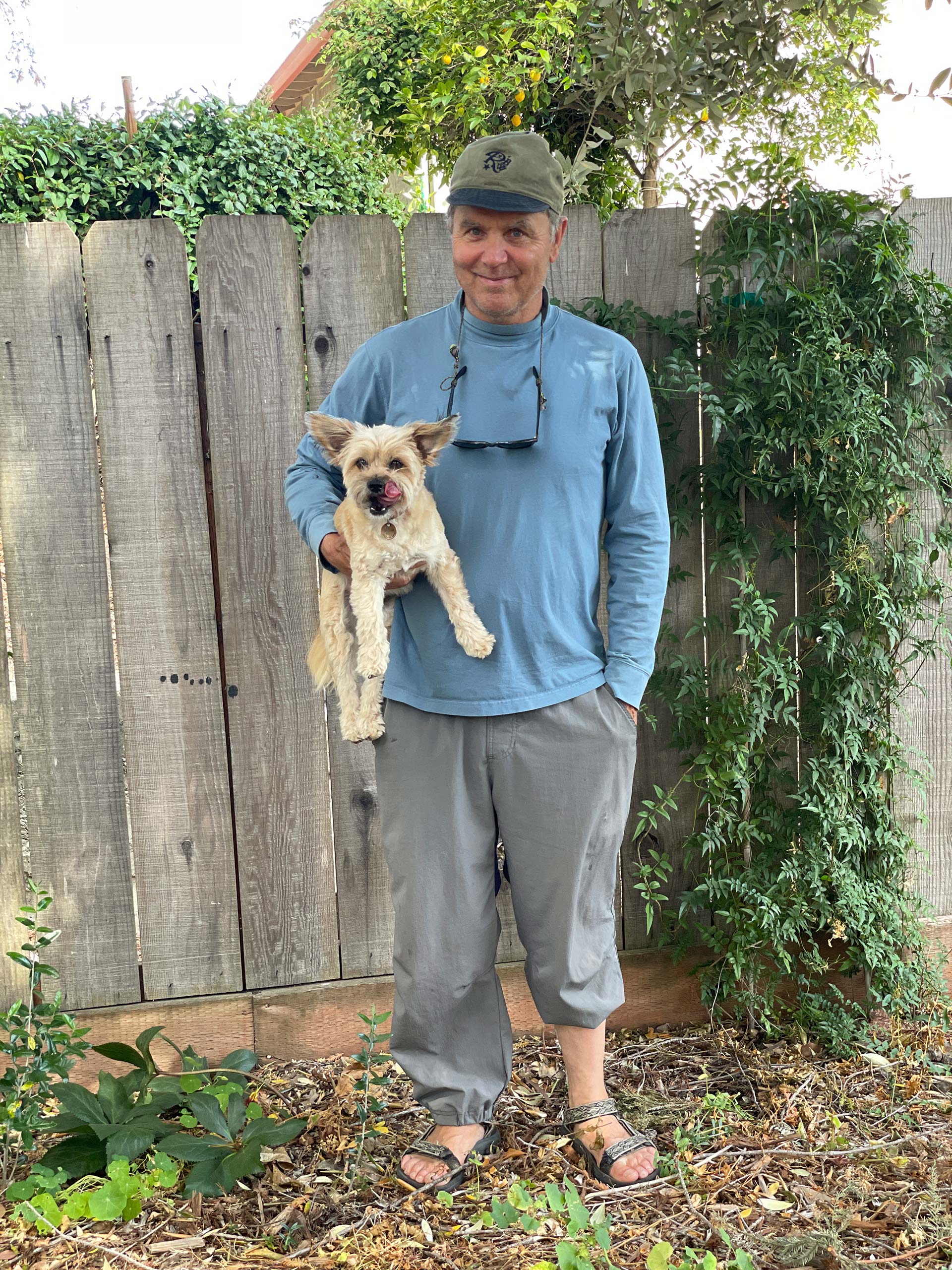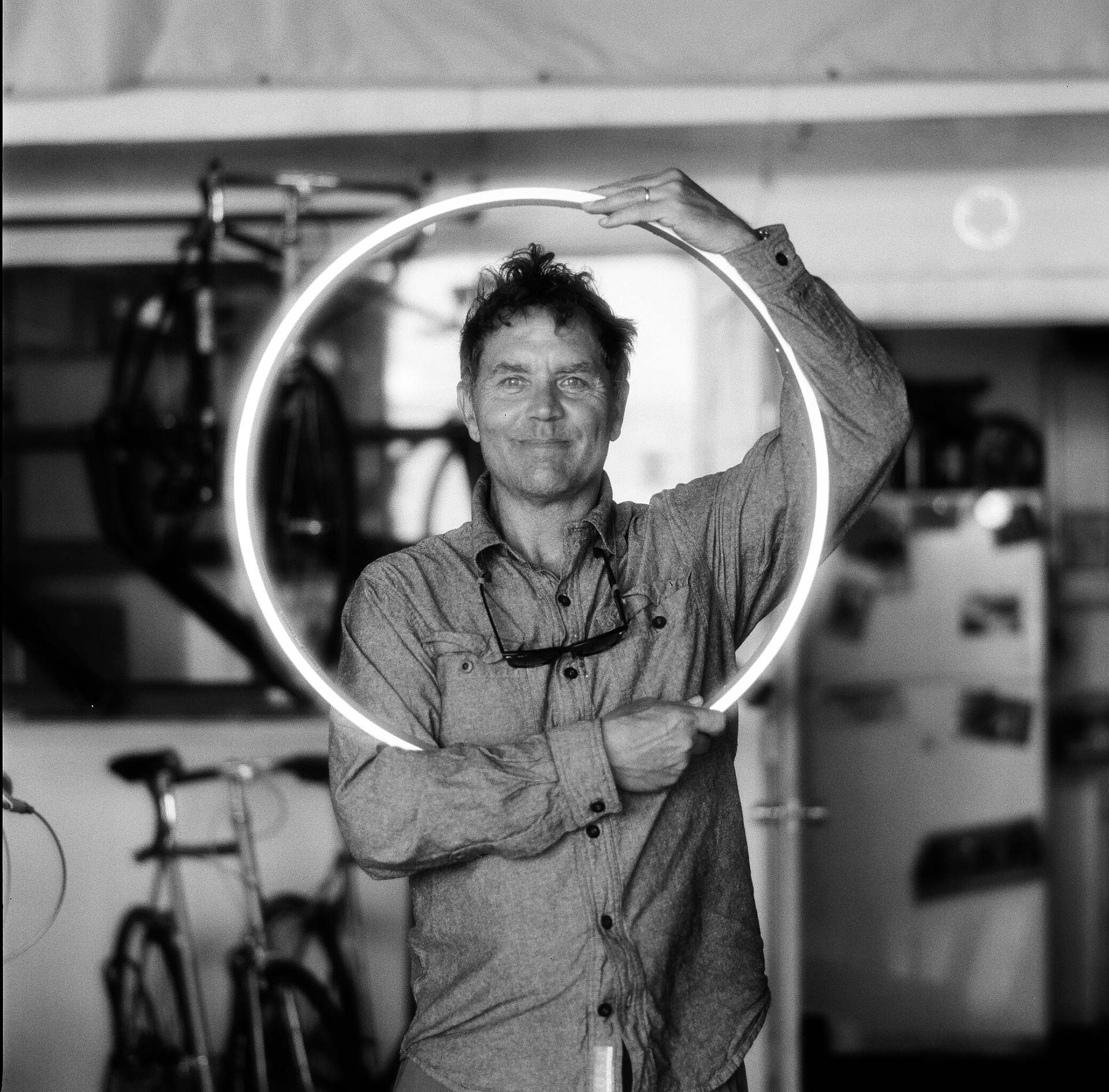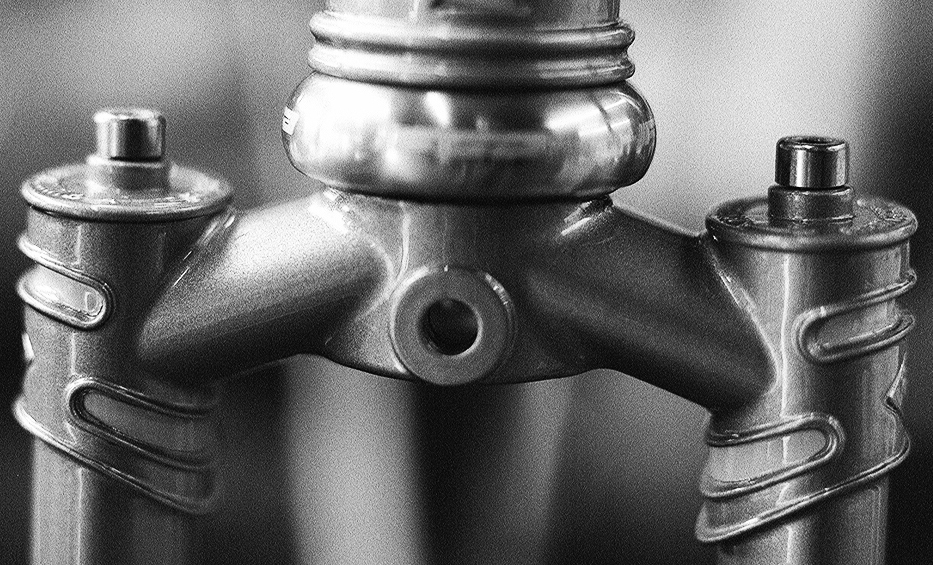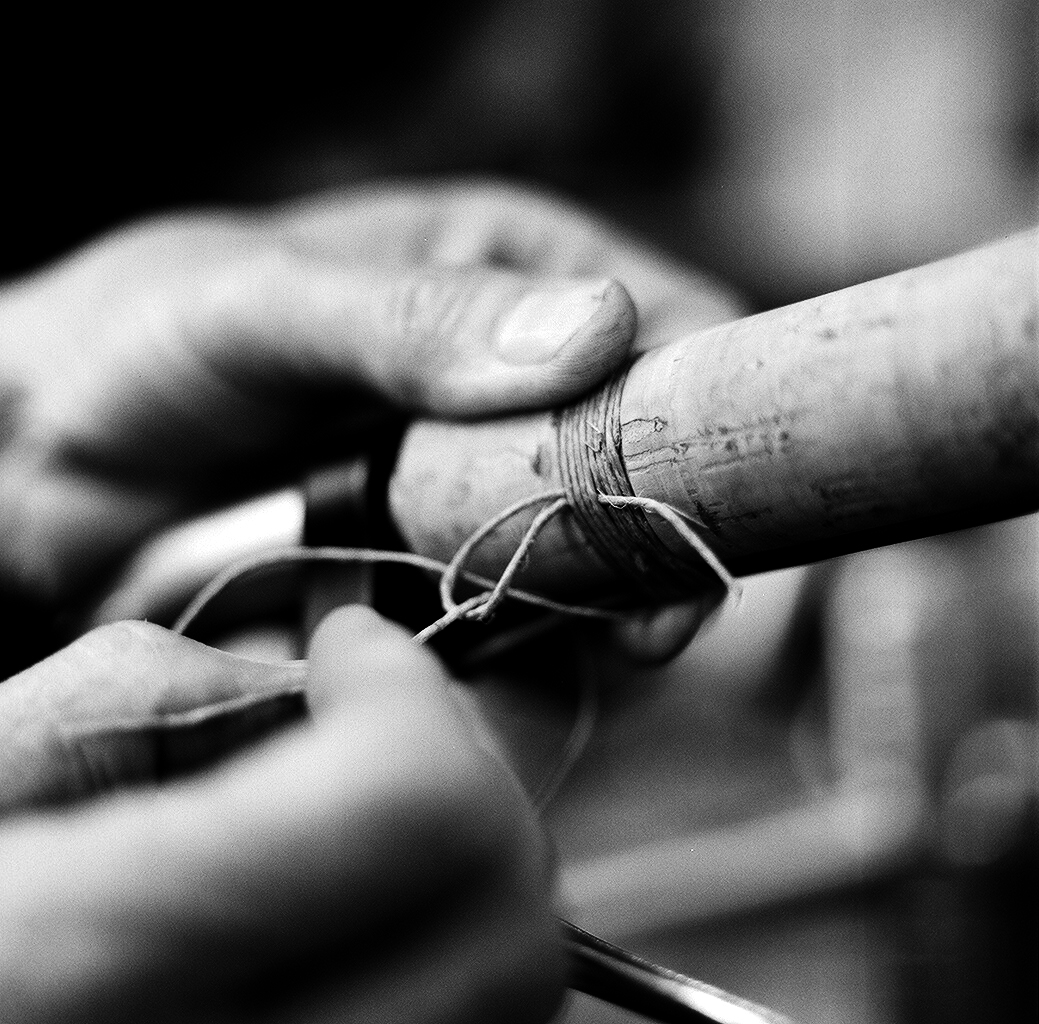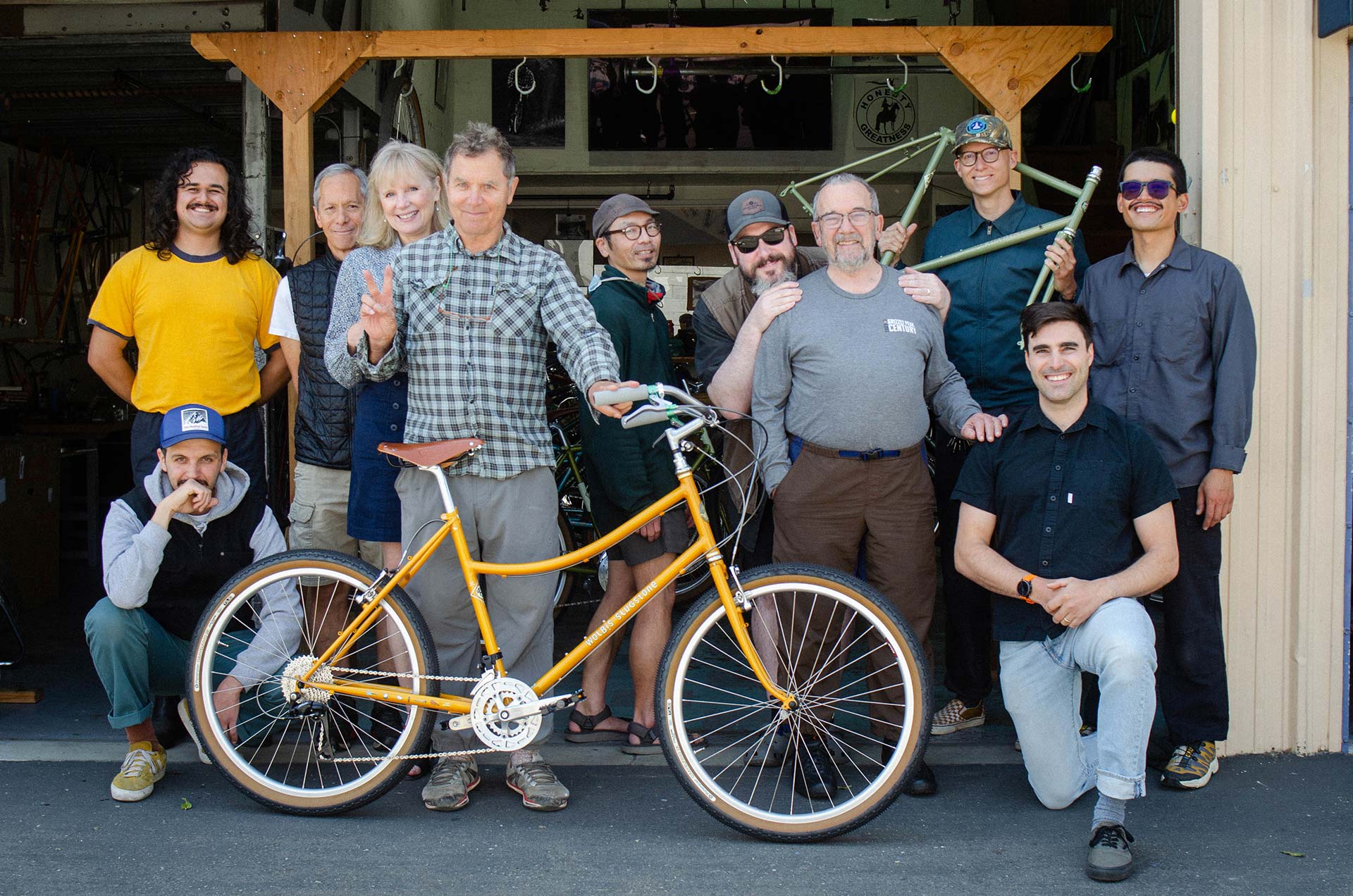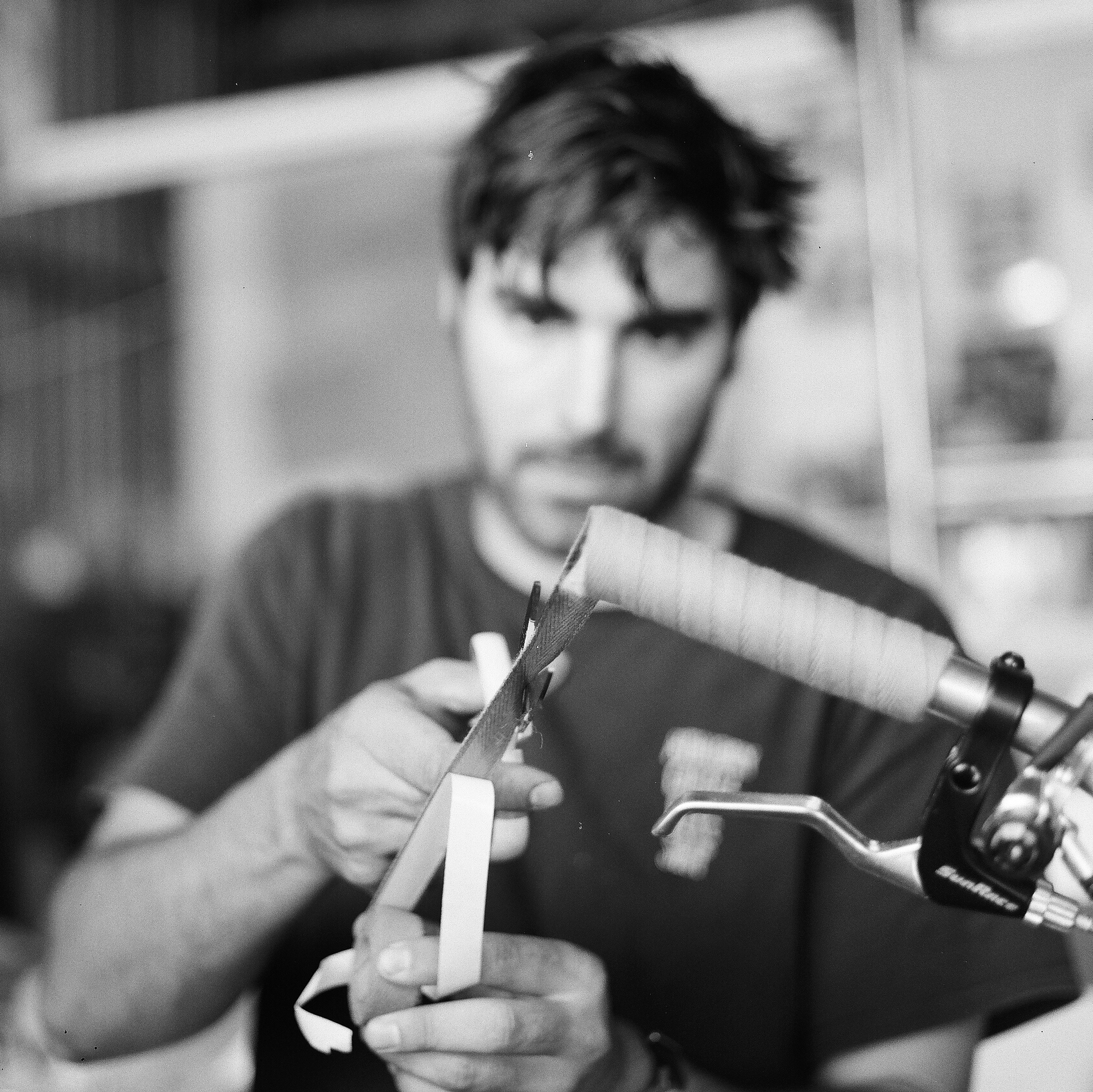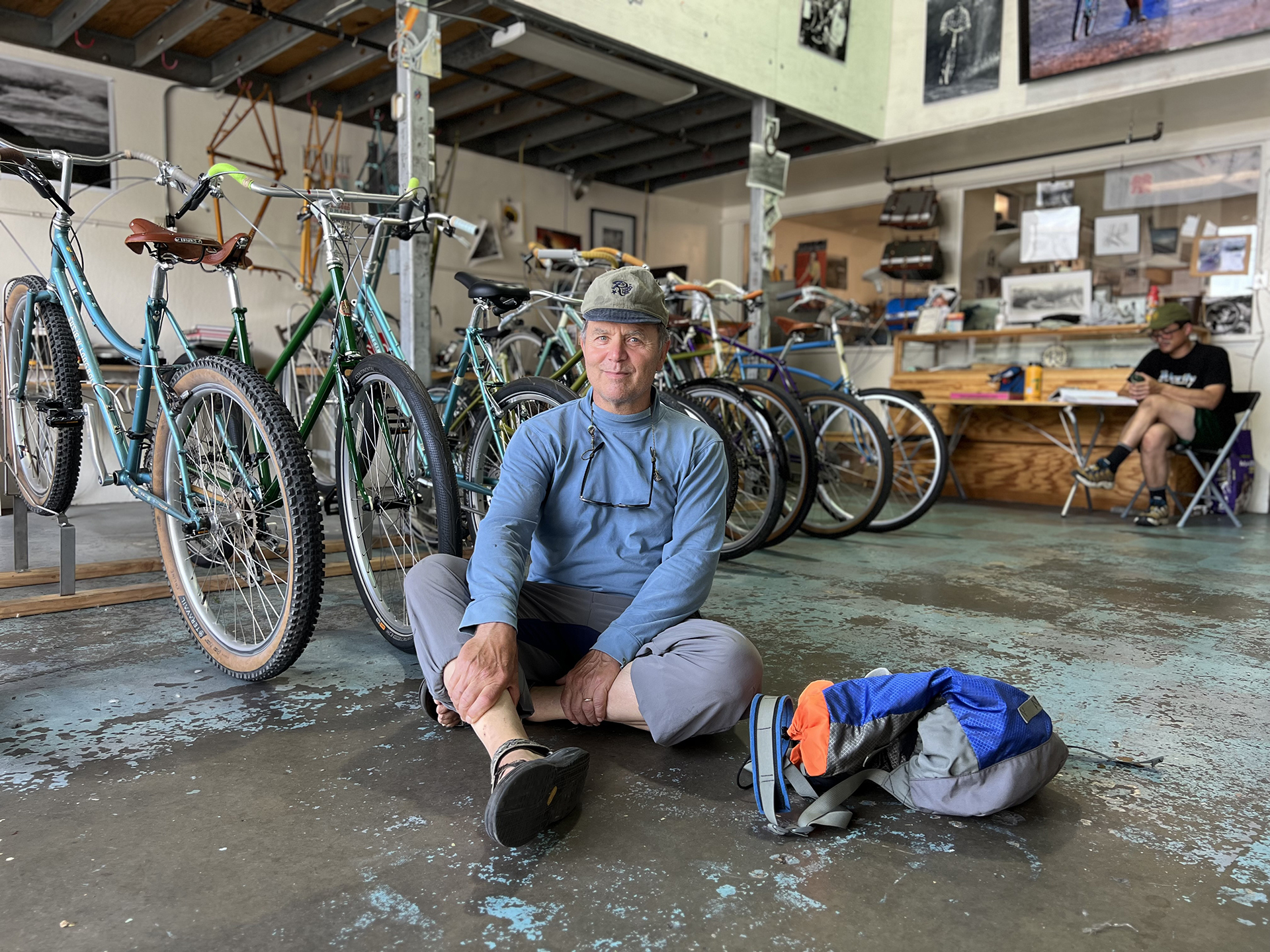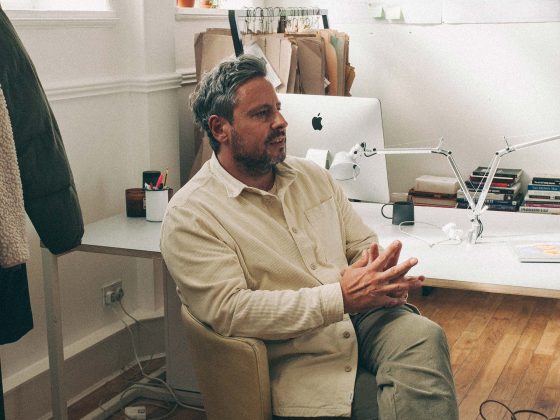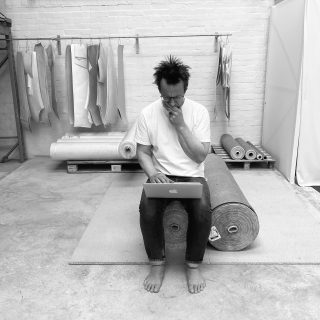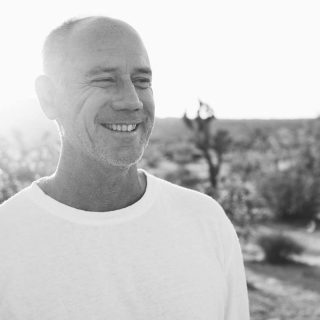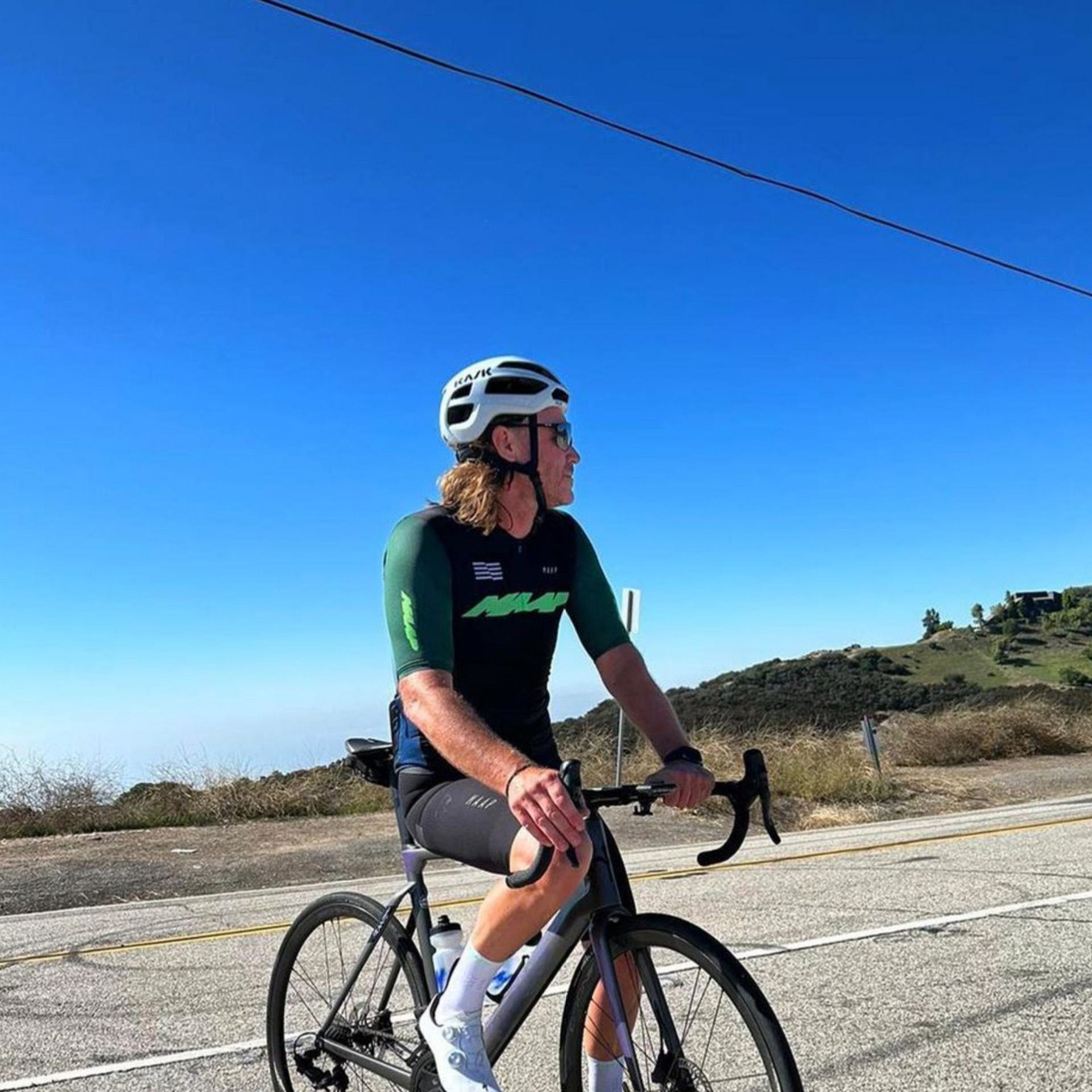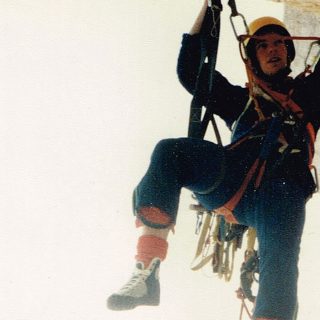An Interview with Grant Petersen, founder of Rivendell Bicycle Works
A seriously in-depth chat with the legendary bike designer
Grant Petersen has done a lot for the humble bicycle. First through Bridgestone USA (the North American arm of the massive Japanese tyre company who produced some seriously influential bikes in the 80s and early 90s), and then with Rivendell Bicycle Works—the company he started in 1994—he’s been pushing for what you could maybe call an alternative bicycle future, where enjoyment, practicality and longevity take precedence over gimmicks, fads and The Next Big Thing™.
This might sound like common sense, but at a time when mainstream bikes have become unrepairable masses of high-tech jiggery-pokery, his ideas around hard-wearing steel frames and good ol’ simplicity (alongside the countless other uncomplicated concepts he laid down in his 2012 book Just Ride), have set him apart as a revolutionary.
What’s more, whilst his so-called ‘velosophy’ is no doubt influential (the recent uptick in baskets and swept-back handlebars being bolted onto old steel mountain bikes can probably be traced back to him), the way Rivendell operates is also well ahead of the proverbial curve. They’ve sold straight to their customers since the mid-90s and were publishing their own zine, the Rivendell Reader, long before people in meeting rooms started chatting about content marketing. He might also be the world’s biggest Bob Dylan fan.
Anyway, enough of the spiel. I caught him before a fishing trip to peck his head about everything from the early days of Rivendell to the art of finding satisfaction in struggle. Whether or not you’re into bicycles or not, Grant’s wise words here should give you something to think about…
Your book Just Ride came out in 2012. Since then it feels like people have embraced the ideas you wrote about—whether that’s riding practical bicycles, or going camping on their bike or just riding in normal everyday clothes. As someone who has been talking about this stuff since the late 80s, does this give you a bit of validation?
‘Validation’ is a nice complement, but the thing is—nothing in it was original or should have been revolutionary. I think ‘just riding’ as I think of it is a historically natural way to ride, but I wrote it at a time when racing was taking over, and racing hasn’t let go, it’s still influencing so many people. It’s not my concern how anybody rides, but Just Ride, I think, exposes them to an alternative to being obsessed with personal bests, beating their friends on social rides, and cheating the wind on inconsequential and optional recreational rides.
As I think I say somewhere in the introduction, it’s ‘just riding’ without racing influences, which tend to make everything from attitudes to shoes kind of weird. Most people in the world ‘just ride’. But I am aware of, and proud of, the influence it has had. I’ve received many kind notes.
What sort of person picked that book up?
I don’t think my peers read it, although if they had it might have been a little helpful. I think it was mostly new riders who bought it, or people who were tired of spandex and drop bars and special shoes and liked somebody with experience telling them it was OK to be comfortable, and not make every ride a workout, and wear halfway normal clothes on a bicycle. But if you’ve been dressing and riding like that for 20 years, you could easily take offence to a stranger saying it’s not necessary. I rode that way for 25 years.
Anyway, it didn’t do well in bike shops, that’s for sure. Most bike shops sell a repair book or two, and maybe a Lance or a Tour scandal tell-all, and don’t want to stock a book that questions modern trends and racing dogma. There’s a home furnishings store that sold about 10 or 15 titles, and Just Ride was one of them—for 11 or 12 years, even—and that really made me happy. We sold a lot of them at Rivendell, though. Two hundred a year, or so. I think it’s on its final lap. It needs updating, I’d love to do that, but I’m not sure it’s in the cards.
Subscribe to our newsletter
Do you remember when you first got hooked on bikes in the first place? What was it that set this whole thing off?
My dad HAD a car, but wasn’t a car-nut, so car-lust wasn’t imprinted on me. I needed a way to get around, so I rode my bike. From age 12 to 14 I didn’t have a bike or want one, but I was hitch-hiking to high school, and then on the first Earth Day (April 22, 1970) we high-schoolers were encouraged to get around without burning fossil fuels. My dad asked me, “Want a bike?” and I said sure, so he bought me one.
I have never wanted a car and have never made a car payment. The family has an inherited 2003 Prius, and it works great, but I’ve driven it less than an hour total in the last three and a half years. I accept rides in cars, I’m glad my wife and friends drive, because sometimes a bike won’t do. If I knew I wouldn’t ever hurt anybody by car, I’m sure I’d drive more. Riding a bicycle is easier and normal for me. I ride for fun, to commute, shop, to the dentist, and so on. I’ve never loved riding as much as I do now. I’ll never get tired of it. I liked bicycles first because they meant I didn’t have to hitchhike or walk, and I still like them for that, but I ride for fun all the time, too.
You started Rivendell in 1994. Was there anything specific you set out to do with it?
I set out to keep certain kinds of bikes and bike parts alive and relevant. Steel frames—especially lugged ones, threaded headsets, quill stems, saddlebags, friction shifting, and so on. Things that will work as well in a century as they did then and do now, but were not happening in the mainstream—they were being discontinued, because they were considered obsolete, old technology. That was our goal, and still is, and we’ve been OK at it. Looking back, it seems we shouldn’t have lasted two years.
You were selling straight to customers back in the mid-90s, and were making your own magazine well before anyone used the term ‘branded content’. Was this just common sense?
When I worked for Bridgestone’s bicycle division in the U.S. between late 1984 and 1994, our biggest department was Accounts Receivable. You ship dealers bicycles and give them thirty or sixty days to pay, and then they don’t. They order more bikes while not having paid for the ones you sent them 50 days ago, and if you don’t send them more bikes, they say they won’t be able to pay for the ones they’ve already sold. Your ‘best’ customers end up being the ones who order the most and still owe you $60,000. I didn’t want that to happen. I knew we’d never be any dealer’s bread-and-butter bike, so we’d be the last to be paid.
“I set out to keep certain kinds of bikes and bike parts alive and relevant—things that will work as well in a century as they did then and do now.”
So when I started Rivendell in late 1994 I wanted to sell direct to bicycle riders, who are used to paying for stuff before they get it. Another benefit is the direct, unfiltered communication. We can explain things to them without the dealer filtering out the details or nuances or background of this or that, because either they think their customers don’t care, or they can’t understand it themselves, or because it threatens their bread-and-butter bikes.
Our bikes are all steel, so a dealer who sells mostly carbon and aluminum bikes is probably going to sum up ours as ‘retro,’ but that disrespects all that we put into them. They’re contemporary, futuristic in their own way, and we can say that without fear of hurting sales of our Treks or whatever.
The name was a homage to an older brand wasn’t it?
Well, yes, but it was kind of a combo. Of course I’ve read and loved Tolkien—and my wife has read the Trilogy thirteen times—but more directly, I was influenced by Rivendell Mountain Works. In the early ’70s, a guy named Larry Horton started RMW, and they made really smart, non-trendy, I’d even say pioneering and super-innovative packs and clothing and ultimately a tent for climbers, mountaineers, and stuff like that.
I was doing all that, and after using normal stuff from the North Face and others, I got ahold of a catalog, ordered some stuff, and it changed everything for me. The catalog was so well-written, and I’ve tried to copy it.
I read somewhere that old Chouinard Equipment catalogs heavily influenced the style and tone of Rivendell and the way you wrote at Bridgestone too. What was it about those that set them apart?
I gradually took over the Bridgestone catalogs, and around 1989 or so, a friend and industry big shot, Tom Franges, sent me an 1890 Eagle Bicycle Company catalog, with a post-it-note that said, “Now THIS is a catalog.” It was jam-packed with information, even technical information that clearly assumed the reader was capable of understanding the design/engineering minutia and so on… in 1890! I’ve since read dozens of bicycle catalogs from the late 1870s onward. Catalogs were better back then—the content, the presentation, the fonts, the layouts, everything. I grew up reading outdoorsy catalogs, and they were OK in the late ’60s, decent through the mid-’70s, and have largely nose-dived since.
The Chouinard catalogs you mention were from 1972/73. They heavily influenced the Bridgestone catalogs from 1992, 1993, and 1994, and I’m proud of those. But compared to Chouinard’s, they were nothing. Chouinard was a climber-blacksmith who took a stand against the rock destroying tools and techniques, even though he made and sold some of the damaging tools—hammers and pitons, mainly. He had the nerve to scold himself and his own climbing crowd. A lot of it was written by Tom Frost and Doug Robinson, and it was powerful and convincing, and I was blown away. I was a climber back then, and holding that catalog felt like holding something magical and precious and unbelievable all at the same time.
I don’t know how many others felt that way, but look what it led to: Yvon Chouinard demonstrating how to have a business that isn’t too destructive, and still cares for the earth. I can’t say I or Rivendell have lived up to his standards, or even close, but what we generate online and on paper is as acceptable as it is only because of the Chouinard influence. I’m not hanging onto his ankles and getting dragged along, I’m don’t even have him in sight. But what Bob Dylan is to songwriting, Yvon Chouinard is to business, and if you knew how much of a Bob Dylan fan I am, that would kind of explain how much I admire Yvon Chouinard. And Patagonia, or whatever.
From the outset Rivendell has never tried to be everything to all people. Do you think that’s part of its success and influence? It certainly doesn’t seem watered down.
Well, on the surface it seems that way, and I’ve probably said that somewhere along the way, but it’s true of any bike company or clothing brand or anything else. What you must mean is that we are doing “unpopular” things and at some level realize that and don’t give a hoot. That’s true, but what’s true behind it is that even though we’re ‘nichey’ or however somebody might put it, every one of us here at Rivendell feels that all the big mainstream bikes are the weird ones.
We aren’t for everybody in the sense that not everybody likes our style. But functionally, our bikes work for almost everybody almost all the time, so…in that sense, we’re The People’s Bikes. Except for the prices, which we can’t help. There are plenty of perfectly good bikes for under $1,000, just like there are some bizarre bikes for over $6,000.
What are you most proud of with Rivendell? Looking back on all this stuff, is there a frame or a detail or an idea you’re especially glad to have contributed to the bike world?
Me, personally, I’d say it’s the crew we have, and the culture, and just being able to retain them so long. We have several over 20 years, others over ten, and even the new people—four to five years—I don’t think they plan on leaving. There’s no backstabbing, competitiveness, or resentment. Everybody works hard, because everybody else is working hard.
We’re all glad to have helped keep certain things alive that the mainstream tried to kill off, and still doesn’t care about. Lugged, steel frames, threaded headsets, friction shifting, leather saddles. We’ve helped legitimize comfortable high-end bikes, bigger tires, saddlebags, baskets, higher handlebars, platform pedals on fancy bicycles, normal clothing for riding, a functional, fun, non-competitive approach to bicycle riding, and in general, elevating the status of ways of riding that used to be considered for beginners only, or for the weak.
I hope we’ve normalized bicycle riding, and de-glorified racing. We sell really good stuff for everyday use. Also we give away $50,000+ every year to a handful of people or charities who seem to need it. We gave $1,000 to one of your countrymen, an upholsterer named Vincent Snowball because he, kind of prophetically, had a hard time paying his electric bill and was freezing. I read about him in the New York Times, a famous American newspaper.
Terms like ‘retrogrouch’ or ‘luddite’ are usually thrown at anyone who hasn’t wholeheartedly embraced whatever new thing they’re being sold – but instead of being a backwards mentality, is it actually progress in a different direction?
Whether Ned Ludd was real or a compilation, I’m not sure where the experts stand on that one—he’s kind of like Jesus Christ in that way. But I do know that what the real or fictionalized Ned Ludd cared about was workers’ jobs and rights and safety at a time when industrialization was literally killing children, the environment, and abusing workers. And now ‘Luddite’ is a pejorative, tossed like a hand grenade at anybody who questions ‘progress’ or technology!
Today Ned Ludd would be a human rights champion, but it’s too late now, because ‘luddite’ is too entrenched as a bad thing. It’s an easy and low cheap-shot and chuckle when it is applied to me or anybody else who questions technocracy, who doesn’t whole-hog embrace the easiest and slickest way to perform an already simple task.
“It’s fun to stumble until you have enough skill to stumble less—my version of bicycle-riding hell would be riding an autopilot bike that always worked mind-numbingly perfectly.”
On the topic of bicycles, but this can apply to anything, I think many people, even most people, enjoy manipulating simple tools more than they enjoy pushing buttons that take over. When you do that, it removes you from the device.
It all depends on what’s at stake. A life? I’d trust an MRI or an X-Ray, and arthroscopic surgery more than I’d trust a hunch leading to exploratory carving. But when it comes to something like a bicycle ride—and there are other examples, I’m sure your readers have their own lists—it is FUN to get results when results aren’t guaranteed. It’s FUN to stumble until you have enough skill to stumble less. My version of bicycle-riding hell would be riding an autopilot bike that always worked mind-numbingly perfectly.
I remember hearing somewhere about a baking kit in the fifties, and how people didn’t buy it because it made things too easy, to the point where the company who made it had to reel it back a bit so there was more of a sense of achievement. It feels like we’re maybe at that point with things now, with more and more people taking up a new craft or riding their bikes to distant lands. Have you noticed this kick-back or shift in the States too? Are at least a small percentage of people growing tired of ‘easy’?
Well, a lot of what happens in the market is kind of like a snake growing at both ends. The avant garde or technology end grows first because it’s so sellable; and the other end responds—and I mean people who see through the fancy or just aren’t attracted to it, they respond by going the other direction. In the late ‘90s when 9-speed cassettes were new, single-speeds exploded. Maybe single speeders, maybe they didn’t have the money or whatever to buy new 9-speed bikes, so they went nuts with one-speeds, kind of nose-thumbing at the niners. Then mainstream brands started offering upscale one-speeds.
Runway fashion used to be ridiculously glitzy clothes that nobody would buy, but they moved the needle for normal clothes and fashion brands for rich people. Then poor people and other rejectors started wearing torn denim, and when that became a movement, it started showing up on runways, and has now trickled down to high fashion. I know at Rivendell, we’re not out of that loop. I see bikes becoming more like cars and computers, and it makes me dig in deeper. If a bike part has low origins like that, my tendency is to reject it. Suspension, hydraulics, disc brakes, electronics, tubeless. They all work, they all ‘have their place’ or whatever, and nobody is dumb or a patsy for using them, but I don’t think bikes are improved by them, and you won’t find car or computer parts on our bikes. This may keep us small.
Related to that, I think there are different kinds of struggles. Some people struggle to find the high-cache item that eliminates the struggle. To them, it’s kind of like the task is shopping. They try to get the latest, whether that’s a 13-speed cassette or a car that drives itself, or a bike that eliminates muscle strain and sweat.
Then there are people who don’t mind a skill-struggle in the early stages and a little sweat when using—but that’s a smaller group, with limited growth potential, because skilled users who don’t mind a learning curve aren’t always looking for high-tech solutions to the kinds of “problems” that arise on optional recreational bicycle rides.
Thinking about all this stuff, Is life and enjoyment and fulfilment really about finding the right level of struggle?
I’ve never thought about it, but yes, now that you mention it, I’d go along with that. It’s fun to go from hard to easy, it’s satisfying, it makes you feel human or normal, or something like that. Newborns may struggle to find the nipple, and it prepares them for a lifetime of struggles, with many successes. But it’s harder to monetize a whetstone than an automatic knife sharpener, and on and on. In bicycles, the trend is always towards more and easier. Making a new version easier to use is how you get people to replace what they have one tenth of the way into its useful life.
What constitutes a good bike ride for you? Hiking or cycling or pretty much any other recreational activity is usually judged in terms of time or distance, but how do you judge it?
For me, for this time in my life, a perfect ride has no cars in the way. It has hills I have to grunt up, lots of undulating flats with cool breezes and great views, and descents that make me concentrate but are mostly rideable. It has sections I have to walk because they’re too hard. It’s with a friend or two that I get along with and understands that a good ride includes gazing-at-nature breaks.
If it’s more than four hours, it includes some fun food. It absolutely has photo-ops, and I’ll have my OM-1 or Hasselblad with me, loaded with HP-5 film. My riding buddy will have to be patient as I set up for a few shots. It won’t be muddy. Lots of it will be on narrow, forested trails, at six to ten mph. I ride that perfect-for-me ride about 80 times a year. It’s easy for me to love riding my bicycle.
Sounds very nice indeed. How do you break beyond that thing of judging success by numbers? Whether it’s the time it took to ride from one place to another, the amount of ‘views’ a video on Youtube had or the money someone made in a day, people are really hooked on numbers.
I think you need inviolable beacons or something—a role model, a song lyric, something you can hold onto in the face of all the forces trying to get you to slide the other way, something like that. On a bicycle ride, it probably helps—it helps me, for sure—to think: OK, I don’t have to do this, nothing is at stake, no matter how long it takes me or whether I can pedal up this steep rocky climb without walking, my wife will still love me, my home will still be there, I’ll still eat and have my friends. So, it’s a perspective thing. That’s how it is for me, anyway.
That makes sense. Thinking of your love of Bob Dylan and Yvon Chouinard, are they sort of what you mean about having inviolable beacons?
Well, “love” is kind of strong, but I’ll admit to insane admiration for them both. The Dylan and Chouinard beacon stuff is kind of true, but before I’d ever heard of them, when I was between about five and ten, three quarters of my friends back then, got Wham-O slingshots, jigsaw-cut from a block of wood, about an inch thick. I wanted one, but my dad said no—not to the slingshots—but to the Wham-O slingshots. I showed him a picture of one and he said, “Look at how chunky it is. That’s because the grain isn’t following the contours. They’d break if they weren’t so fat.” Then he showed me his slingshot—he was 37 at the time, but still had a slingshot, because you never know. He said, make it from a tree fork, and it’s stronger and skinnier, because the grain follows the contours of the fork. When you’re four or five and your dad is explaining nature’s structural engineering to you, it makes a big impression. For me, it meant I felt sorry for the kids with their fat Wham-O slingshots, because my dad showed me how cool a real fork is.
Then when I was ten or so and started hunting and fishing, my friends were shooting pumps and automatics and fishing with spinning gear—this was back when ten-year small kids and pre-teens did that stuff—but my dad said, “Well, we shoot doubles and fly-fish.” I’d never hunted or cast a fly rod, but I loved my dad, so that’s how I went, and it’s another example of not doing the popular, normal stuff. Fly casting doesn’t come easy to a ten-year old, but I finally got it.
With a double, you break open the gun and there are your shells. You put them in and take them out with your fingers. With an automatic or pump, some invisible magic happens, and I still don’t know how that works. I don’t like it in bicycle parts, either—hidden headsets, hidden chainring bolts, cables, anything hidden, I don’t like. I want to see how something works, and I want it accessible if I have to fix it. I haven’t hunted in half a century, but I see the slingshot and double and fly rod influences in my bicycle preferences. I’ve made about fifty sling-shots, and I still fly-fish.
The Bob Dylan obsession, if it’s that, started in 1969, when I was fifteen. He’s never been normal for his time, and yet he had such beautiful poetry. I never got into popular music—I liked some Neil Diamond, but I liked Tap Root Manuscript, his African folk music songs, more than, like, ‘Cherry, Cherry’. But once you dive into Bob Dylan you kind of divide all other music into Bob Dylan and Not Bob Dylan.
Yvon Chouinard is out there on his own, too. I would like to make it clear, also, that admiring these guys is not me saying I’m just like them, or even close. Bob Dylan is one of a kind, Yvon Chouinard is one of a kind, and they do what they do better than I do what I do.
How does it feel to be looked up to like that yourself? A lot of people see you as a bit of a hero, is that a strange position to be in?
Well, that’s an unexpected question. People who know me from living or working with me or being my friends—they know the real me and I think they like me—but they don’t look up to me. I know my contributions and I don’t downplay them, but I have a lot of help in all of them, and I am, I think, widely overestimated—it’s easy to do when you don’t know the guy.
I have average intelligence, but I read a lot. I was a mediocre student in school, but I didn’t care. In high school I got a D-minus in geometry and now I design bicycle frames. When I got married and had a family, I was scared to death of not being able to support them, and I couldn’t have a job that required driving, because–we’ve already been through that. So I worked really hard all along, and I can’t believe it has worked. I don’t want to be ‘known’, I just want to put something down that the crew here can feed off and improve when I’m gone. Not dead, just–off fishing somewhere. But meanwhile, I love my work, I have no plans to retire, and I feel lucky, not talented.
What inspires you now? Is there anything out there you see now and think, “I like how they do that”?
Hilleberg and Springbar tents. Gransfors axes. Blue Lug bicycles in Tokyo does us better than we do. They don’t make bikes, they do sell our bikes—and others—but their approach and style and creativity and intelligence inspire me and all of us here at Rivendell. I like Patagonia’s approach to business, but not their mountain bike ads. I like the Ochs und Junior watch brand, but I would never spend that much, so I adore my Mondaine.
Photographically-wise, I love Hasselblad cameras, those simple boxes that work so well and are so easy once you get over the fiddly hump. I admire and love Ilford film, because they focus on and support groovy black-and-white films. They don’t ‘play the field’, they home in and nail it. I like everything about the Olympus OM-1 camera. I like Tom Whittle’s and Henk Verhaar’s bamboo fly rods, and their different approaches, and their convictions. In bicycles I love and admire Richard Sachs’s stubbornness and strength, and he has inspired me. We have different approaches, but he keeps me strong. He hasn’t sold out, and he cares at a deep level that I can relate to and draw from.
I like businesses and products and people that think the product is more important than numbers, growth, popularity, and all that. I understand that things have to sell, they need a certain amount of market support, but once you’re big, you have to care more about market support than the product. It can’t be any other way. Product-driven becomes market-driven, and that means the most customers and the lowest common denominator. So you have Filson clothing softening everything so it doesn’t need breaking in, and offering pastels and all. I understand that, I’ve had Filson jackets that never broke in, and Filson Double Tin Pants that would stand up by themselves, but were hard to walk in. But I bought these things for city use, so—my fault!
“I like business and products and people that think the product is more important than numbers, growth, popularity, and all that.”
When a big company buys a smaller company, or just another company, they do it with the idea of using the established cachet as a launching pad into a new audience, and that means catering to the tastes of people who didn’t like the original stuff. So it has to get softened or cheapened, or re-stylized, and the next thing you know you have outdoorsmen buying pre-washed Filson shirts for their girlfriends and wives. But Filson triples revenue this way, and it’s good for everybody but not necessarily for the wearables, or the packs. It happens over and over again with everybody. One of your interviews was about that guy who liked Eddie Bauer’s old clothing. Eddie Bauer went mainstream and got soft, and where are they now?
Abercrombie and Fitch is another. Growing big and becoming mainstream wrecks a lot of things for more money, but it also employs more people. That’s the good thing about being big, but it’s not always good for the things they make. There may be exceptions, maybe not, I don’t keep track, and I’m not in a position to criticize businesses I don’t know about, and which employ thousands of people. But big makes it harder to be good, for sure.
I worked at REI’s Berkeley store for ten years, ending in late 1985, and in the mid-‘80s we started selling Gumby, which some of us knew wasn’t a good sign. It’s a way to reach out to more people, but more people isn’t always better. The product entry bar gets lower and longer, and it’s supposed to be good, somehow, to have millions and millions of people out there driving to the woods and wilderness and being happy with their plastic outdoor goods, until the next upgraded plastic version comes along in two years. It’s a system that works.
It’s a tough thing to break out of. Wrapping this up now, here’s my last question… all around the world the bicycle is pretty much universally adored. What is it about these contraptions that causes such obsession amongst people?
I’ll speak for the whole world: bicycles are simple and fun. They’re an any-age device. Who likes riding a bicycle more—a five year old or an 85-year old? I’d say it’s tied, and I can absolutely state with 100 percent confidence that nobody in the world likes riding a bicycle more than I do. It’s impossible. I ride every day I have access to a bicycle, which means every day I’m not fishing. I’ve ridden 98 percent of the days I’ve lived since April 22, 1970, the first Earth Day.
‘Bicycle,’ as a word, is beautiful, fun to write and to say. I’ve stopped calling them ‘bikes’, even. This is my own thing, not my suggestion to anybody else; but ‘bikes’ can mean motorcycles or eBikes, and ‘bicycle’ gets right to the exact point. To me, ‘bicycle’ tops the list of the five most fun words in the English language. Also, there’s ‘lollipop’, ‘platypus’, ‘chamomile’, and ‘salamander’.
The only people who don’t love bicycles are those who don’t ride them and those who don’t know what they are—otherwise, there’s no excuse. Somebody, or millions of people might not like the kinds of bicycles I like—well, that’s pretty clear—but they love their kinds of bicycles up to 90 percent as much as I like my kind.
Find out more about Rivendell here. Interview by Sam Waller.
